We begin the day at the Vhils show, "Fractals", at the Delimbo gallery. Vhils is a Portuguese artist known for a 'street art' style; we've seen his work around Lisbon. He's especially well-known for cutting into surfaces to create large portraits. Delimbo is a lovely space, like so much of Sevilla, hovering between old and new. In this case, Vhils has cut into the back wall of the gallery. When asked, what will happen to the work when the show closes, the owner shrugs, as if to say, 'everything is temporary'.
One piece shown behind the gallery counter is a cityscape of Sevilla from El Mirador of Las Setas. As we are just a block away, we decide to try that out.
The view from El Mirador of Las Setas is exactly as expected; yet, sometimes you embark on 'tourist attractions' with dread and find out it's a pretty good. Obviously, it's important we caught the 'attraction' on a bright, clear day. The views are tremendous, and the play of light in the coffers and curves of Las Setas adds fascination. As far as 'attractions' go, it's 'above average'.
Our next stop should offer even better views – La Giralda.
Leaving El Mirador, we encounter the Plaza Jesus de la Pasión, which is on the other side of the church from the Plaza del Salvador. We aimlessly wander past the towers of Iglesia de San Bartolomé on our way to La Giralda.
The entrance to the Catedral is near the base of La Giralda. Once inside, we can see that the structure enclosing the Patio de los Naranjos is slightly separated from the exterior wall. We pass underneath a crocodile and an elephant tusk, through the Puerta del Lagarto, and into the darkness.
Inside La Giralda there is a wide, spiraling square ramp, designed for a horse and rider to make the trip multiple times a day for the call to prayer – and thereby leaving plenty of room for tourists. The masonry joints are linear rather than expressing the bricks (visible outside). The pattern acts like racing stripes, visually adding velocity as we ascend.
But our climb is gradual, with plenty of window stops, and views through the flying buttresses. Soon, we are above the buttresses and able to scan the top of the vaults, bare to the sky (no pitched roof). The buttresses form coffers, and the vaults create wavy interruptions – kind of like Las Setas, and then again, not at all like it. From the parapet, we gaze down on the Fuente de la Farola, Calle Mateo Gago, and the Plaza del Triunfo.
Instead of a central nave and an aisle on each side, there are two aisles on each side. The Sacristia Alta and Capilla Mayor (altar) fill the two bays to the crossing, so the church space is already shortened by four bays. The altar is also gated and inaccessible.
The two bays past the crossing are taken by the Coro (choir) and it's two incredible pipe organs. At the crossing, in what would normally be the north transept, there is a tall, open chapel area, just in front of the door to Patio de los Naranjos. This is the Altar de Plata (silver altar), and seems to serve as a more 'public' altar area. That leaves just three bays to the Puerta Mayor, making the Catedral feel 'wide', and 'shallow'.
Perhaps the one place we grasp the scale of the place is by the Puerta Mayor, looking over the Coro to the Caprilla Mayor. Here, we can see the breadth from side to side, and the depth, as least as far as the vaults of the Sacristia Alta. The fragmented nature of the layout must be the result of the mosque-to-cathedral conversion.
Along the south aisle, across from the Coro and the pipe organ, there is one jumbo-sized chapel, the Capilla de la Virgen de la Antigua. Above the doorway are the banners of the regions of Spain. The side of this chapel opens to the transept and Columbus' tomb.
The Tumba de Cristóbal Colón is set inside the doors of the south transept. A colossal clock sits on a balcony above the portal, known as the Puerta de San Cristóbal. On the wall opposite the Capilla de la Virgen de la Antigua is an over-scale and over-nostalgic frescoed portrait of (we assume) Columbus – an angel sits on his shoulder holding a globe, and an old man lights the way. The coffin is carried by bearers from four regions of Spain (by their tunics: Castile, León, Aragon, Navarre).
The south aisle also provides access to several other rooms, including the the Sacristía Mayor and the Sala Capitular.
The Sacristía Mayor (sixteenth century) is a domed, 'Plateresco' room, with rings of carved figures descending from the oculus. The lowest circle is filled with beasts and chimera, so this may be an 'Inferno-like' composition. The arches are trimmed with putti, and are tied together with a lion-head cornice. The columns are fluted, spiral-fluted, carved in relief, and carved in the round.
Sacristía Mayor and the Sala Capitular are separated by a long hallway known as the Antecabildo (sixteenth century), with an elegantly coffered ceiling and several fabulously gruesome relief panels.
The Sala Capitular (sixteenth century) is a Mannerist, elliptical domed room. From a tight, disorienting transition, with a stepped ceiling, along the outside of the ellipse, and we arrive at a compact, centered doorway. Only a small portion of the room is habitable inside the velvet ropes.
Opposite the door, within the dome, is a painting of 'La Inmaculada'. The lower section of the room is dressed in red fabric, up to about eye level. The floor is an elliptical 'grid', much like the Piazza del Campidoglio in Rome. The entire arrangement is a real entertaining challenge for our eyeballs.
We leave the Catedral through the Patio de los Naranjos and the Puerta del Perdón. From the Patio, there are terrific views of the Catedral between the orange trees.
We get word that the bull ring, the Plaza de Toros de la Real Maestranza de Caballería (eighteenth century), is free today. Approaching the 'Real Maestranza' from the north, we get lost trying to find the front door. Along Calle Adriano, the 'ring' meshes with the streetscape. We see a wide door marked "Puerta Nº 15", and then an arched opening under a kind of tower-top. This takes us around the outside; the path becomes circular, and we can see the lantern and dome of the small chapel associated with the 'Real Maestranza'.
We finally find the entrance on the south side, facing the Guadalquivir. The tour goes, first, into the Museo Taurino. It's an savage sport (I admit I find the idea of it offensive), but the history and the architecture are still intriguing. It is, at least, unlike anything we've ever seen before.
We end the day with a walk and dinner in Triana, which compares to the Oltrarno in Florence. We cross the Puente Isabel II (Puente de Triana). At the end of the bridge we discover a tiny temple and bell tower, the Capilla del Carmen. The tops are clad in swirling tile and ceramic finials; already, there's more color.
The bridge also leads right to the Calle San Jacinto, a vibrant mall with stores, pharmacies, boutiques, and restaurants. Triana has a great neighborhood feel. We turn onto Calle Alfareria and explore the ceramics shops. We have one of the best dinners of the trip in a nearby restaurant that's installed in an old pottery factory.
After dinner, we slow-walk it along the river. Tomorrow is the train to Granada, but we leave Sevilla wishing we had one more day.
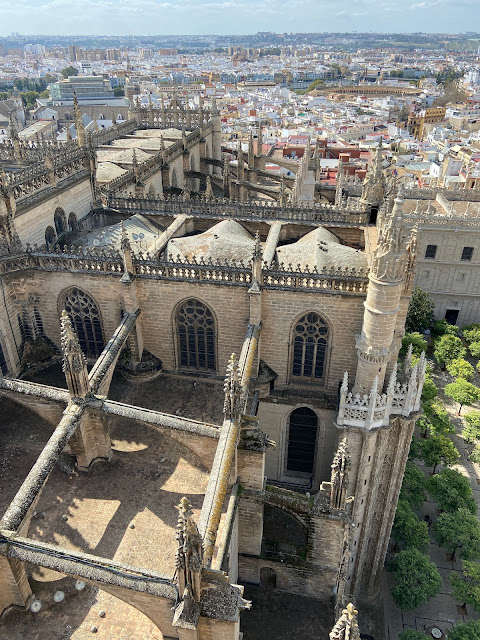








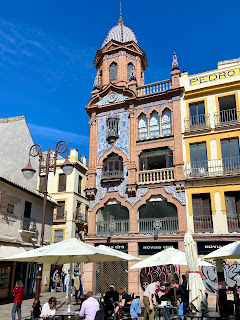




















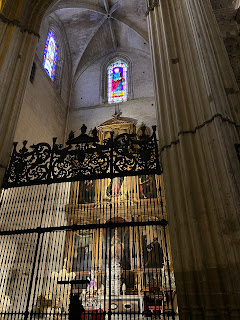

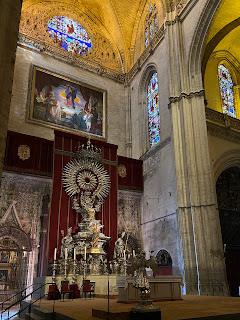









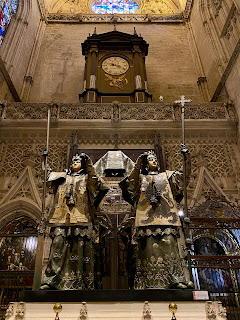




















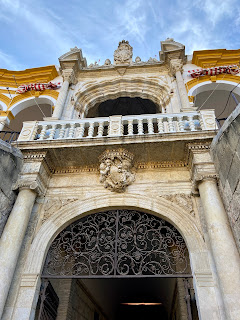










2 comments:
It appears for one to access the entry portal to the Sala Capitular (elliptical domed space) one is forced to walk within a dramatic (mysterious?) curved passage (concentric) around the outside of the space. It also appears to be the sole means of ingress /egress. Mannerism indeed!
olá Peter – yes, there is only the one door for the tourists, bt the floor plan suggest that there is a door and a small square room on the opposite side, tho there is only the slightest hint of disruption in the red wall covering behind that chair (?). trippy!
Post a Comment